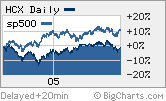 |
 |
| Standard & Poor's health care index has fallen 3 percent over the past 18 months vs. a 6 percent gain for the S&P |
|
|
|
| Tamiflu tug of war
|
| As bird flu panic spreads, demand for the influenza medicine—and the shares of its suppliers—is getting feverish. Among the beneficiaries: Donald Rumsfeld. (Full story on FORTUNE.com)
|
|
|
|
NEW YORK (FORTUNE) -
Concerns about drug patent expirations and meager new-product pipelines have sidetracked pharmaceutical stocks -- which makes six undervalued stocks a buy.
Standard & Poor's health care index has fallen 3 percent over the past year and a half, while the S&P 500 has risen. Why? Pharma industry tracker IMS Health expects growth in drug sales in 2006 to be the lowest in ten years. And pricing pressure from doctors and hospitals is putting a crimp in the earnings growth of medical device companies.
But the fundamental case for health-care investing has changed little. Baby-boomers are entering a stage of life when medical problems become more common, and the clamor for health care will almost certainly outpace demand for computers, fashion, home electronics or just about anything else historically tabbed as a growth industry.
There's a short-term case for health stocks too. Federal Reserve rate hikes, higher energy costs and a cooling real estate market all point toward slower economic growth in 2006. A.G. Edwards market strategist Al Goldman says that in such an environment, investors are likely to swap out of cyclical sectors -- technology and housing, for example -- into more defensive areas like health care.
"When bull markets and economies start putting on some age, the bigger-name defensive growth stocks get more attention," says Goldman.
Here's six such issues that FORTUNE recommends.
Teva
Teva (Research) is in the business of reining in rising medical costs, not reveling in them. Teva's products include generic versions of once-pricey blockbusters like antidepressant Prozac, allergy medication Allegra, and antibiotic Augmentin.
Though Teva is near the high of its 52-week range, it is still reasonably valued, with a price/earnings ratio of 20, well below its five-year average of 29.
Stryker
Stryker (Research) is a medical-device company active in hip and knee replacement, a business where hospitals seem to be rebelling against the 45 percent price increases since 2001. Still, even if the price of joint replacements were to flat-line, UBS analyst Patrick Pace, who has a $69 target price for Stryker, thinks earnings would still rise 18 percent next year on volume growth and the strength of Stryker's other business lines, such as surgical instruments and artificial spinal disks.
Pfizer
One of the sector's biggest names, Pfizer (Research) is trading at historically low valuations. Investors have been spooked by the fact that the drugs coming off patent now and over the next few years (including Zithromax and Zoloft) represent about 25 percent of the company's existing sales. Also, lower-priced competition is cutting into sales of Lipitor, its blockbuster anti-cholesterol drug. The final straw for a lot of money managers came in October, when Pfizer withdrew its earnings guidance for 2006.
Says Todd Lowenstein, who has been buying Pfizer in his HighMark Value Momentum fund: "As value players, we see a company with a bulletproof balance sheet -- $15 billion in cash and no net debt. They're generating $8.5 billion a year in free cash flow, and when you add in the 3.6 percent dividend yield, you're looking at a 10 percent cash return for this company."
Amgen
The problems at biotechnology leader Amgen (Research) don't run nearly as deep, but you wouldn't know it from its recent stock market performance. The stock fell 15 percent from mid-September to late October.
"There's still a lot of growth in their core products," says Brandi Allen, co-manager of the Live Oak Health Science fund Indeed, sales of Aranesp (anemia treatment), Neulasta (infection-fighter for chemotherapy patients), and Enbrel (rheumatoid arthritis) are all expected to increase more than 30 percent this year. Plus, Amgen's new-drug pipeline includes promising treatments for colon cancer, gastrointestinal cancer, and bone disease.
Invitrogen and Waters
Another set of health-care stocks that have taken it on the chin lately is life sciences companies like Invitrogen (Research) and Waters (Research), which make equipment used in new-drug research.
Recent sales and earnings have been disappointing, which is why the stocks are down 20 percent and 29 percent, respectively, from their 2005 highs. Allen sees a buying opportunity.
"Toward the end of every year, investors get nervous about what the National Institutes of Health [research] budget is going to look like for the next fiscal year," she says. "I don't see how the NIH could make drastic cuts in growth rates given the concerns about avian flu and bioterrorism."
Read the full story on FORTUNE.com.

Six healthy choices
The health-care sector is in Wall Street's doghouse -- which makes now a good time to buy. |
| Amgen (AMGN) |
$60.24 |
20 |
Market overreacted to 'only' 38 percent jump in Aranesp sales. |
| Pfizer (PFE) |
$17.17 |
10 |
Great balance sheet, 3.6 percent dividend -- and totally out of favor. |
| Stryker (SYK) |
$57.50 |
19 |
Flat prices for joint replacements won't flatten earnings. |
| Teva (TEVA) |
$63.01 |
20 |
Generic drugs help lower runaway medical costs. |
| Waters (WAT) |
$68.87 |
16 |
Nobody expects a long-term decline in drug R&D. |
Source: FORTUNE
Price/earnings ratios based on estimated 2006 earnings. | Prices as of: Apr 13 10:00 |
|